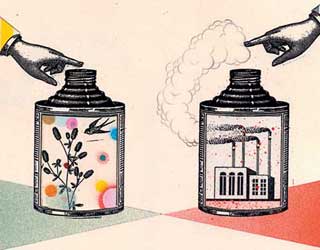
Illustration: Mark Allen Miller
While world leaders hash out whether to tax carbon or trade it, the rest of us wrestle with our own environmental quandaries: Paper or plastic? Dishwasher or sink? Drive or fly? Here’s how to pick what’s best for the planet.
Take the Mother Jones EcoQuiz! Click on the questions to see the answers, or view all answers.
Paper or Plastic?
Paper bags, even those made from recycled paper, require at least as much energy as plastic to make and transport, and produce up to 90 percent more greenhouse gases. But plastic bags end up in trees, wildlife gullets, and landfills, and don’t be fooled by “biodegradable” claims: Even if they do break down, they can leave behind plastic fragments. Solution: byob.
Netflix or Video Store?
The mail carrier takes the same route every day, so a few dvd envelopes add little to his carbon footprint. Online rentals’ computer use and packaging create a small amount of carbon, but the video store—and the schlep there—generates about 65 percent more emissions.
Laptop or Desktop?
Laptops remain more energy efficient than desktop systems, but they’re harder to upgrade, and it’s usually better to replace individual parts than to buy a brand-new computer. Smaller desktops get better energy performance: Apple’s Mac Mini has been estimated to draw about a fifth as much power as a Mac Pro when both are in idle mode.
Read the Paper in Print or Online?
Logging, pulping, printing, and distribution are energy intensive, but servers require a constant flow of electricity, and your computer uses juice, too. According to a 2007 study by Stockholm’s Centre for Sustainable Communications, it all boils down to how long you peruse the headlines: Thirty minutes or less and you should read online; any longer, and dead trees (or, better yet, recycled paper like, ahem, this magazine uses) remain the better bet.
Candles or cfl?
Need mood lighting for a romantic dinner? Paraffin candles produce toxic soot and sometimes lead. (Beeswax and soy wax burn more cleanly.) Modern dimmer switches, which work by turning the current on and off more than a hundred times every second, require fewer trips to the store than candles, but they can damage fluorescent bulbs.
Manual or Automatic Transmission?
Gearheads insist manual is the way to go, but most of today’s automatics are just as fuel efficient. Look for six- or seven-gear systems. The Department of Transportation suggests the biggest savings are in systems with computerized clutches, found in European models such as Audis.
Wash Your Car or Keep It Dirty?
It’s true that a wash ‘n’ wax can reduce your wind resistance and boost your fuel economy. On the other hand, a layer of filth might even mimic a golf ball’s dimples, encouraging air to follow a car’s contours and minimizing the energy-sapping zone in the wake.
Car Windows Down or Run the AC?
Depending on your car’s size, cranking the AC lowers fuel economy by as much as 20 percent; opening the windows can have a similar effect, because of aerodynamic drag. The greenest option is to slowly bake; if that doesn’t appeal, open your windows in the city, when drag matters less, and save the AC for the highway.
Idle Your Car or Turn It Off?
If you’re stopped for more than 10 seconds, you’ll save fuel by switching your engine off. Most hybrids turn off automatically when stationary, and some conventional cars in Europe (sorry, none stateside yet) do too.
Gas or Diesel?
Diesels are more fuel efficient by 20 to 40 percent, but produce up to 400 times more sooty “black carbon,” a potent warming agent. Don’t hold out for biodiesel, which is often produced using soy and palm oil farmed on deforested land. Instead, look for diesel hybrids, which should hit the market within two years and could improve fuel economy by up to 55 percent. Until then, gas hybrids remain the greenest option.
Workweek: Five Days or Four?
A quarter of US businesses now offer shorter workweeks or other flexible scheduling options. The Pew Center on Global Climate Change reports that short weeks reduce drivers’ total mileage by no more than 0.6 percent—because we end up driving to the mall or beach anyway—but at least the decline in rush-hour congestion cuts other commuters’ travel time and emissions.
Fake Leather or Real?
Vinyl is made from petroleum, but cows’ belches generate 20 percent of US methane emissions. Curing agents—used by 90 percent of US tanneries—produce 800,000 tons of potentially carcinogenic waste. Solution: Vintage.
Laundry: Night or Day?
You’ve switched to an energy-efficient front-loader and dialed down its water temperature; can you go greener still by washing your clothes in the wee hours? While off-peak energy may be cheaper, it’s not necessarily cleaner: Most utility companies use coal and nuclear “base load” plants to make off-peak energy, and top off with gas and diesel plants, which emit fewer greenhouse gases, during the early evening peak. Still, late-night laundering eases the need for power at high demand times. Researchers at the Pacific Northwest National Laboratory say that America’s existing plants only run at full capacity about 5 percent of the time; the unused off-peak capacity could power enough plug-in hybrids to replace 84 percent of American cars, trucks, and suvs, cutting oil imports by more than half. Until there’s a Chevy Volt in every driveway, late-night laundering is the way to go.
Disposal or Trash Can?
Disposals use less water all day than a single toilet flush and increase electricity usage by only 0.1 percent—and that’s more than offset by the savings from flushing waste instead of trucking and dumping it. New York’s Department of Environmental Protection found that ground-up kitchen scraps didn’t clog sewers or treatment plants; another study suggests that trash collection produces four times as much greenhouse gas as disposals. Composting is best, but if your backyard pile isn’t aerated—by a fistful of worms, for example—noxious bacteria will churn out more greenhouse gases per pound of waste than filthy city dumps.
Dishwasher or Sink?
Hand washing uses about five times as much water as a high-efficiency dishwasher, but sink suds are more energy efficient—British scientists estimate that for eight or fewer place settings, hand washing saves power.
Paper Towels or Electric Drier?
A 30-second blast of hot air creates half the greenhouse emissions of two paper towels. Use one sheet, or stick to the electric drier.
Pill or Condom?
Long-lasting devices like diaphragms create less waste than single-use rubbers, which can end up in sewers, clog waste treatment plants, and potentially pose a threat to wildlife. The Pill, while waste free, sends small amounts of estrogen into waterways, possibly harming fish. But whatever works for you—the toll of a few prophylactics is nothing compared to the environmental consequences of population growth.
Diapers: Disposable, Flushable, or Cloth?
In 2006 diapers made up 2.1 percent of US municipal waste. But a study by Britain’s Environment Agency found that the energy impact of producing and disposing of paper diapers was almost identical to that of laundering cloth ones—the same as driving between 1,300 and 2,200 miles over the course of a kid’s diaper-wearing years.
Local conditions matter. If you’re in the well-watered Northeast, where waste is often trucked to neighboring states, cotton diapers look good; if you’re in a parched Western state, stick with disposables—or better yet, plastic-free, flushable gDiapers, which biodegrade in about 90 days. For the truly hardcore, there’s “elimination communication”: Forgo diapers and intuit when Junior’s gotta go.
Fake Grass or Real Grass?
If summers are dry where you live, ditch your croquet court for succulents, zen rocks, or plastic grass (flamingo optional).
Death: Buried or Burned?
When a conservationist croaks, what’s the greenest way to say goodbye? The average cremation releases more than 35 pounds of carbon (burials generate fewer than 9), and high temperatures can vaporize dental fillings—in the UK, cremations create up to a sixth of the country’s annual mercury emissions. Mowed and fertilized graveyards are hardly carbon neutral, so some cemeteries now recycle old plots; others are considering vertical burials. Swedish researchers have figured out how to freeze-dry bodies in liquid nitrogen; the resultant corpsicle can be ground into ecofriendly dust. But for now, best to splurge on a biodegradable coffin and plan on pushing up daisies.















